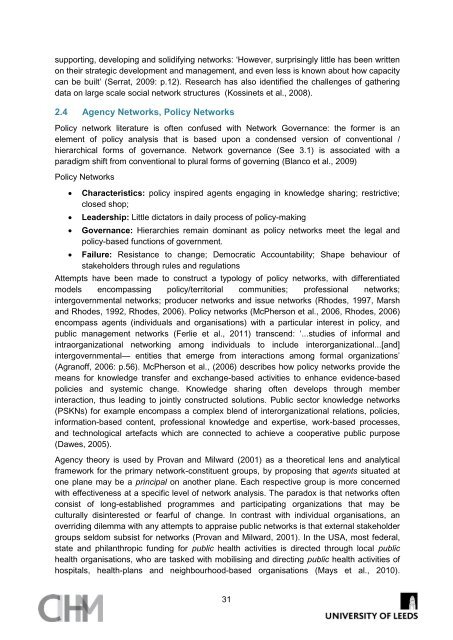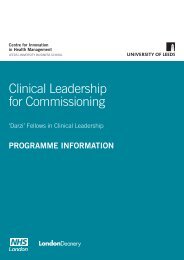Networks - a briefing paper for the Health Foundation - Centre for ...
Networks - a briefing paper for the Health Foundation - Centre for ...
Networks - a briefing paper for the Health Foundation - Centre for ...
- No tags were found...
You also want an ePaper? Increase the reach of your titles
YUMPU automatically turns print PDFs into web optimized ePapers that Google loves.
supporting, developing and solidifying networks: ‘However, surprisingly little has been writtenon <strong>the</strong>ir strategic development and management, and even less is known about how capacitycan be built’ (Serrat, 2009: p.12). Research has also identified <strong>the</strong> challenges of ga<strong>the</strong>ringdata on large scale social network structures (Kossinets et al., 2008).2.4 Agency <strong>Networks</strong>, Policy <strong>Networks</strong>Policy network literature is often confused with Network Governance: <strong>the</strong> <strong>for</strong>mer is anelement of policy analysis that is based upon a condensed version of conventional /hierarchical <strong>for</strong>ms of governance. Network governance (See 3.1) is associated with aparadigm shift from conventional to plural <strong>for</strong>ms of governing (Blanco et al., 2009)Policy <strong>Networks</strong>Characteristics: policy inspired agents engaging in knowledge sharing; restrictive;closed shop;Leadership: Little dictators in daily process of policy-makingGovernance: Hierarchies remain dominant as policy networks meet <strong>the</strong> legal andpolicy-based functions of government.Failure: Resistance to change; Democratic Accountability; Shape behaviour ofstakeholders through rules and regulationsAttempts have been made to construct a typology of policy networks, with differentiatedmodels encompassing policy/territorial communities; professional networks;intergovernmental networks; producer networks and issue networks (Rhodes, 1997, Marshand Rhodes, 1992, Rhodes, 2006). Policy networks (McPherson et al., 2006, Rhodes, 2006)encompass agents (individuals and organisations) with a particular interest in policy, andpublic management networks (Ferlie et al., 2011) transcend: ‘...studies of in<strong>for</strong>mal andintraorganizational networking among individuals to include interorganizational...[and]intergovernmental— entities that emerge from interactions among <strong>for</strong>mal organizations’(Agranoff, 2006: p.56). McPherson et al., (2006) describes how policy networks provide <strong>the</strong>means <strong>for</strong> knowledge transfer and exchange-based activities to enhance evidence-basedpolicies and systemic change. Knowledge sharing often develops through memberinteraction, thus leading to jointly constructed solutions. Public sector knowledge networks(PSKNs) <strong>for</strong> example encompass a complex blend of interorganizational relations, policies,in<strong>for</strong>mation-based content, professional knowledge and expertise, work-based processes,and technological artefacts which are connected to achieve a cooperative public purpose(Dawes, 2005).Agency <strong>the</strong>ory is used by Provan and Milward (2001) as a <strong>the</strong>oretical lens and analyticalframework <strong>for</strong> <strong>the</strong> primary network-constituent groups, by proposing that agents situated atone plane may be a principal on ano<strong>the</strong>r plane. Each respective group is more concernedwith effectiveness at a specific level of network analysis. The paradox is that networks oftenconsist of long-established programmes and participating organizations that may beculturally disinterested or fearful of change. In contrast with individual organisations, anoverriding dilemma with any attempts to appraise public networks is that external stakeholdergroups seldom subsist <strong>for</strong> networks (Provan and Milward, 2001). In <strong>the</strong> USA, most federal,state and philanthropic funding <strong>for</strong> public health activities is directed through local publichealth organisations, who are tasked with mobilising and directing public health activities ofhospitals, health-plans and neighbourhood-based organisations (Mays et al., 2010).31
















